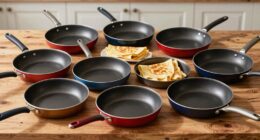A hybrid bike is your go-to option if you’re looking for versatility and comfort. It combines features from road, mountain, and touring bikes, allowing you to ride on various terrains. With a lightweight frame, wider tires, and an upright riding position, it minimizes strain while enhancing stability. You’ll find flat handlebars for better control and disc brakes that offer reliable stopping power, even in wet conditions. Plus, the diverse gear range accommodates different riding styles, from commuting to fitness. Stick around to discover how to choose the perfect hybrid bike for your needs and riding preferences.
Key Takeaways
- Hybrid bikes combine features from road, mountain, and touring bikes for versatile performance across various terrains.
- They offer a comfortable, upright riding position that reduces strain during longer rides.
- Equipped with wider tires, hybrid bikes enhance stability and traction on mixed surfaces.
- Their lightweight frames and diverse gear ranges make them suitable for commuting, fitness, and leisurely rides.
- Key features include flat handlebars, disc brakes, and a variety of frame materials for improved comfort and efficiency.
Definition of Hybrid Bikes
When it comes to versatility in cycling, hybrid bikes embody the perfect blend of features drawn from road, mountain, and touring bicycles. These bikes are designed to cater to a variety of riding styles and terrains, making them a popular choice for many cyclists.
In addition to their adaptability, hybrid bikes can also reflect a sense of style similar to Balinese design characteristics, where comfort and functionality harmoniously coexist. If you’re looking for a bike that offers a comfortable riding position, a hybrid bike is ideal. It allows you to ride upright, reducing strain on your back, neck, and shoulders, which is particularly beneficial for long-distance rides and daily commutes.
Hybrid bikes often come with wider tires that provide enhanced stability and traction, enabling you to navigate both paved roads and light off-road trails with ease. The frame materials, such as lightweight aluminum or carbon fiber, contribute to the bike’s efficiency while minimizing total weight.
Furthermore, the range of gears on a hybrid bike accommodates various terrains, from flat roads to hilly areas. This combination of comfort, stability, and versatility makes hybrid bikes suitable for both casual riders and fitness enthusiasts, ensuring a smooth ride no matter where you go.
Key Features of Hybrid Bikes

Hybrid bikes offer an impressive array of features that cater to a wide range of cycling needs. These bikes are designed for comfortable and relaxed riding, making them ideal for casual cyclists and commuters alike.
In addition to their versatility, hybrid bikes can be personalized with colorful accessories that reflect your style, much like how Indonesian decorative pillows enhance living spaces with vibrant colors and cultural heritage.
Here are some key features to contemplate:
- Flat Handlebars: Hybrid bikes feature flat handlebars that provide better control and a more upright riding position, reducing strain on your back, neck, and shoulders.
- Disc Brakes: Many hybrids come equipped with disc brakes, offering superior stopping power and performance in wet conditions, ensuring your safety during rides.
- Frame Materials: You’ll find a variety of frame materials, including lightweight aluminum and carbon fiber, which enhance comfort and efficiency without breaking the bank.
- Gear Range: The gear range on hybrid bikes varies from single-speed to multi-speed systems, allowing you to tackle both flat roads and hilly terrains effectively.
These features make hybrid bikes versatile and suitable for different cycling preferences, while their wider tires provide better traction on various surfaces.
With the right hybrid bike, you can enjoy a smooth and enjoyable ride wherever your adventures take you!
Comparison With Other Bike Types
@ Midjourney AI Image Prompt: /imagine prompt:An illustration of three distinct bikes: a hybrid bike on a winding path, a road bike on a smooth asphalt road, and a mountain bike on rugged terrain, highlighting their unique features and environments. –v 6 –ar 16:9
Choosing the right bike often involves understanding how hybrid bikes stack up against other types. Hybrid bikes blend the best features of road and mountain bikes, offering a comfortable ride with wide tires and a more upright position. In contrast, road bikes are designed for speed, emphasizing aerodynamics with a lower stance, while mountain bikes focus on rugged off-road performance.
Here’s a quick comparison:
| Feature | Hybrid Bikes | Other Bikes |
|---|---|---|
| Tire Width | Wide tires for comfort | Narrow tires for speed (Road) |
| Stopping Power | Disc brakes for better control | Rim brakes for lightweight (Road) |
| Gear Range | Wider gear range for versatility | Narrow gear range (Road) |
Hybrid bikes excel in versatility, making them suitable for both paved roads and light trails. They typically have a wider gear range than road bikes, allowing for better adaptability to various terrains. Compared to mountain bikes, hybrids are generally lighter and prioritize comfort over technical off-road capabilities. If you’re looking for a bike that balances performance and comfort across different environments, a hybrid bike might be your best option.
Benefits of Hybrid Bikes

One of the standout advantages of hybrid bikes is their incredible versatility, making them perfect for a variety of riding styles and terrains.
Whether you’re commuting to work, enjoying leisurely rides, or getting fit, hybrid bikes adapt to your needs seamlessly. This adaptability mirrors the varied architectural styles found in traditional Indonesian housing, which are designed to suit different regional needs and cultural significance.
Here are some key benefits you can expect:
- Comfortable Riding Position: The upright riding position reduces strain on your back, neck, and shoulders, allowing for longer rides without discomfort.
- Wider Tires: Equipped with wider tires, hybrid bikes offer better traction and stability on mixed surfaces, enhancing your confidence while riding.
- Lightweight Frame: Made from materials like aluminum or carbon fiber, the lightweight frame improves handling and efficiency, making your rides enjoyable across diverse conditions.
- Budget-Friendly: Generally more affordable than specialized bikes, hybrid bikes incur lower maintenance costs, making them a great choice for casual cyclists.
Choosing the Right Hybrid Bike
Finding the right hybrid bike can greatly enhance your riding experience and guarantee it meets your specific needs. Start by evaluating your primary usage—whether you’ll be commuting, enjoying leisurely rides, or focusing on fitness. This will guide you in choosing a hybrid bike that fits your riding style.
Additionally, consider how different styles, such as Traditional Indonesian Style Home Decor, can influence your aesthetic preferences while selecting accessories for your bike.
Next, consider the terrain you’ll tackle. If you plan to ride on a mix of paved roads and light trails, opt for a bike with a wider gear range and durable tires.
Frame materials also play a vital role; aluminum is lightweight and budget-friendly, while carbon fiber offers superior performance for more serious riders, enhancing overall comfort and efficiency.
Don’t skip the test ride! Trying out various models guarantees you find the right fit, as a properly sized bike greatly boosts comfort and performance, reducing the risk of injury.
Finally, research reputable brands and read reviews to compare essential features, focusing on brake types and gear systems that align with your riding preferences.
With these considerations, you’ll be well on your way to finding the perfect hybrid bike for your adventures.
Frequently Asked Questions
Are Hybrid Bikes Good for Beginners?
Absolutely, hybrid bikes are great for beginners! They combine comfort and versatility, letting you ride on various terrains with ease. Plus, their upright position helps reduce strain, making your cycling experience enjoyable right from the start.
What Are the Disadvantages of Hybrid Bikes?
Imagine cruising through the city; hybrid bikes offer comfort but have downsides. They’re heavier, less agile, and struggle on steep hills. You’ll find limited gears and maintenance costs can rise with complex components.
What Is the Point of a Hybrid Bike?
The point of a hybrid bike is to give you versatility. It combines features from different bike types, making it perfect for commuting, leisure rides, and fitness activities, all while ensuring comfort and stability on various terrains.
What’s the Difference Between a Hybrid Bike and a Regular Bike?
A hybrid bike’s designed for comfort and versatility, combining features of road and mountain bikes. In contrast, regular bikes focus on specific terrains, like speed or rugged trails, making them less adaptable for varied riding experiences.
Conclusion
In a world overflowing with bike options, choosing a hybrid bike is like discovering a unicorn that can fly! You get the best of both worlds—speed and comfort—making every ride feel like an exhilarating adventure. Whether you’re cruising through the city or tackling a rugged trail, a hybrid bike transforms your journey into an epic quest. So, gear up, embrace the thrill, and let your hybrid bike take you places you’ve only dreamed of!









